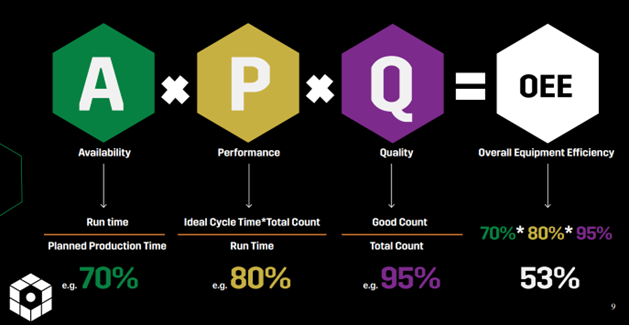




Included in this blog post:
OEE (Overall Equipment Effectiveness) is a commonly used metric for measuring production efficiency. Read this blog post and understand how and why in Real time OEE calculation will benefit your part manufacturing company.
Although the history of OEE goes back to the Japanese automotive industry and was originally developed for Low-mix, high-volume environments, it can also be used to enhance high-mix, low-volume environments by considering its special characteristics. It is of paramount importance to collect the most reliable status information about production equipment. Combining this information with both the production plan and the production control system, one can collect high-quality production information.
By measuring OEE values in this way, you can identify the production processes and equipment’s that cause bottlenecks, downtime, inefficiencies, or quality problems. Calculations can be used to identify losses and development activities.
OEE considers the percentage of production time that is productive and consists of availability, performance, and quality components. Availability measures the actual working time compared to planned time. Performance measures the actual capacity to full capacity. And Quality measures the ratio of good parts.
When it comes to calculating OEE, data quality is key. With the right type of interfacing with machines, it is possible to distinguish different statuses of a machine being tracked. If not properly done the collected data might suggest for example that a machine is running while it is idling or vice versa. Thus, it is necessary to break down and analyze the collected data in such a manner that all status cases can be separated and accurately represented.
The result of the availability calculation depicts when device is in productive use, and the downtime when the device is not in productive use. In this case, it is particularly interesting to understand why the equipment are not running. For this reason, down-time tracking can be added to the OEE calculation. Downtime has a tangible impact on production, revenue, and an asset’s lifecycle costs, therefore it is beneficial to collect this data accurately.
Tracking downtime could help production or maintenance managers identify areas for improvements, where processes could be causing unnecessary delays, and bring clarity to questions on an asset’s availability. Understanding the causes of downtime can be used to develop better standard operating procedures (SOPs) that can optimize operator tasks, material placement and other aspects of equipment operation. Maintenance management can use downtime tracking to develop preventive maintenance, planned downtime can also be reduced by understanding the root causes and the correlations between different events.

The performance calculation accordingly reveals the effect of speed drops and small stops on production efficiency. This is perhaps the most challenging step in calculating OEE for part manufacturing, as it is based on the part’s ideal cycle time, which is distinctive for each piece and can vary greatly between different products. This number can also be hard to estimate. On the other hand, OEE calculation and real cycle time calculation can help refine this number, thus improve production planning and all calculations based on this estimate. In addition, performance can increase understanding of parts and tools changing times, machine cleaning needs, etc.
OEE´s quality component can help identify quality issues and their root causes. This allows you to take corrective action and implement improvements to prevent similar issues from occurring in the future.
Identifying and eliminating inefficiencies: OEE helps manufacturers identify areas of their production process that are inefficient and need improvement. By measuring OEE, manufacturers can identify bottlenecks, machine downtime, and other issues that may be impacting the productivity of their process. They can then take steps to eliminate these inefficiencies, improving overall productivity and profitability.
By measuring OEE, you can set performance benchmarks and track progress over time. This can motivate employees to work towards specific goals and improve overall productivity. OEE measurement can also help identify underutilized equipment, from which information manufacturers can adjust production schedules to make better use of their equipment.
Measuring OEE can help manufacturers identify opportunities for improvement, optimize equipment utilization, improve productivity, enhance quality control, and foster a culture of continuous improvement.
And the best part? The improved performance is also reflected in the company’s financial results. How? Download our OEE Guidebook to learn more!
